
The Curtiss P-36 Hawk, also known as the Curtiss Hawk Model 75, is an American-designed and built fighter aircraft of the 1930s and 40s. A contemporary of the Hawker Hurricane and Messerschmitt Bf 109, it was one of the first of a new generation of combat aircraft—a sleek monoplane design with a retractable undercarriage making extensive use of metal in its construction.

The hyper engine was a 1930s study project by the United States Army Air Corps (USAAC) to develop a high-performance aircraft engine that would be equal to or better than the aircraft and engines then under development in Europe. The project goal was to produce an engine that was capable of delivering 1 hp/in3 (46 kW/L) of engine displacement for a weight of less than 1 lb/hp delivered. The ultimate design goal was an increased power-to-weight ratio suitable for long-range airliners and bombers.
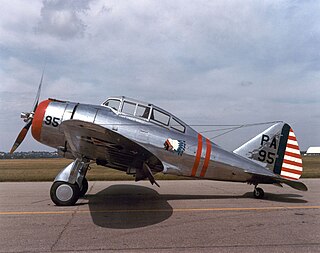
The Seversky P-35 is an American fighter aircraft built by the Seversky Aircraft Company in the late 1930s. A contemporary of the Hawker Hurricane and Messerschmitt Bf 109, the P-35 was the first single-seat fighter in United States Army Air Corps to feature all-metal construction, retractable landing gear, and an enclosed cockpit.

The Curtiss-Wright XP-55 Ascender is a 1940s United States prototype fighter aircraft built by Curtiss-Wright. Along with the Vultee XP-54 and Northrop XP-56, it resulted from United States Army Air Corps proposal R-40C issued on 27 November 1939 for aircraft with improved performance, armament, and pilot visibility over existing fighters; it specifically allowed for unconventional aircraft designs. An unusual design for its time, it had a canard configuration with a rear-mounted engine, and two vertical tails at end of swept wings. Because of its pusher design, it was satirically referred to as the "Ass-ender". Like the XP-54, the Ascender was designed for the 1,800 hp Pratt & Whitney X-1800 24-Cylinder H-engine, but was redesigned after that engine project was canceled. It was also the first Curtiss fighter aircraft to use tricycle landing gear.

The Seversky XP-41 was a fighter aircraft built in the United States in 1939. A single prototype was modified from the last production Seversky P-35 by adding a new streamlined canopy, a Pratt & Whitney R-1830-19 engine with a two-speed supercharger, and revised landing gear. The XP-41 first flew in March 1939. The aircraft was developed in parallel with the P-43 Lancer, and work was stopped when the USAAC showed a preference for the latter.
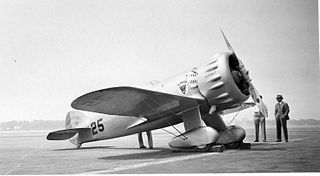
The Wedell-Williams Model 44 is a racing aircraft, four examples of which were built in the United States in the early 1930s by the Wedell-Williams Air Service Corporation. It began as a rebuilding of the partnership's successful We-Will 1929 racer, but soon turned into a completely new racing monoplane aircraft, powered by a large radial engine. Model 44s became the dominant racers of the 1930s, setting innumerable records including setting a new world speed record in 1933.
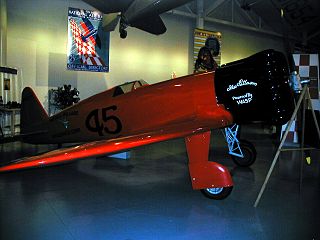
The Wedell-Williams Model 45 was a racing aircraft built in the United States in 1933.

The Curtiss XP-46 was a 1940s American prototype fighter aircraft. It was a development of the Curtiss-Wright Corporation in an effort to introduce the best features found in European fighter aircraft in 1939 into a fighter aircraft which could succeed the Curtiss P-40, then in production.

The Curtiss P-60 was a 1940s American single-engine single-seat, low-wing monoplane fighter aircraft developed by the Curtiss-Wright company as a successor to their P-40. It went through a lengthy series of prototype versions, eventually evolving into a design that bore little resemblance to the P-40. None of these versions reached production.

The Grumman XP-50 was a land-based development of the shipboard XF5F-1 Skyrocket fighter, entered into a United States Army Air Corps (USAAC) contest for a twin-engine heavy interceptor aircraft. The USAAC placed an order for a prototype on 25 November 1939, designating it XP-50, but it lost the competition to the Lockheed XP-49.

The Curtiss P-6 Hawk is an American single-engine biplane fighter introduced into service in the late 1920s with the United States Army Air Corps and operated until the late 1930s prior to the outbreak of World War II.

The P-1 Hawk was a 1920s open-cockpit biplane fighter aircraft of the United States Army Air Corps. An earlier variant of the same aircraft had been designated PW-8 prior to 1925.

The Curtiss XP-71 was a 1941 American proposal for an exceptionally large heavy fighter design. It was intended to serve as an extreme-range interceptor and escort fighter. While significant progress was made in the design phase, no prototypes were ever built, and the design was abandoned in 1943.
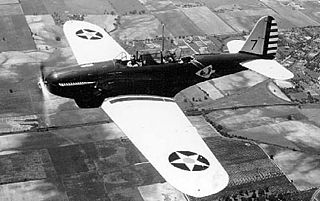
The Consolidated P-30 (PB-2) was a 1930s United States two-seat fighter aircraft. An attack version called the A-11 was also built, along with 2 Y1P-25 prototypes and YP-27, Y1P-28, and XP-33 proposals. The P-30 is significant for being the first fighter in United States Army Air Corps service to have retractable landing gear, an enclosed and heated cockpit for the pilot, and an exhaust-driven turbo-supercharger for altitude operation.

The Boeing Model 15 is a United States single-seat open-cockpit biplane fighter aircraft of the 1920s, manufactured by the Boeing company. The Model 15 saw service with the United States Army Air Service and with the United States Navy as a carrier-based fighter.
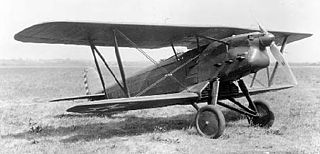
The Boeing XP-8 was a prototype American biplane fighter of the 1920s, notable for its unusual design incorporating the engine radiator into the lower wing.

The XP-13 Viper was a prototype biplane fighter aircraft designed by the American company Thomas-Morse Aircraft Corporation. The airplane was delivered to the United States Army in 1929, but they did not adopt it.

The Boeing XP-15 was an American prototype monoplane fighter.

The Boeing P-29 and XF7B-1 were an attempt to produce a more advanced version of the highly successful P-26. Although slight gains were made in performance, the U.S. Army Air Corps and U.S. Navy did not order the aircraft.
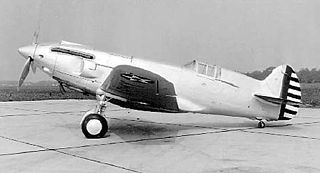
The Curtiss P-37 was an American fighter aircraft made by Curtiss-Wright in 1937 for the US Army Air Corps. A development of the Curtiss P-36 Hawk to use an inline engine instead of the radial engine of the P-36 the fuselage was lengthened and the cockpit moved back. A small number of YP-37 aircraft was built for Air Corps evaluation. The expected top speed was not achieved and the project terminated in favor of the Curtiss P-40.




















